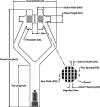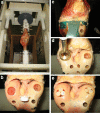A cadaveric analysis of contact stress restoration after osteochondral transplantation of a cylindrical cartilage defect
- PMID: 18292989
- PMCID: PMC2358931
- DOI: 10.1007/s00167-008-0494-1
A cadaveric analysis of contact stress restoration after osteochondral transplantation of a cylindrical cartilage defect
Abstract
Osteochondral transplantation is a successful treatment for full-thickness cartilage defects, which without treatment would lead to early osteoarthritis. Restoration of surface congruency and stability of the reconstruction may be jeopardized by early mobilization. To investigate the biomechanical effectiveness of osteochondral transplantation, we performed a standardized osteochondral transplantation in eight intact human cadaver knees, using three cylindrical plugs on a full-thickness cartilage defect, bottomed on one condyle, unbottomed on the contralateral condyle. Surface pressure measurements with Tekscan pressure transducers were performed after five conditions. In the presence of a defect the border contact pressure of the articular cartilage defect significantly increased to 192% as compared to the initially intact joint surface. This was partially restored with osteochondral transplantation (mosaicplasty), as the rim stress subsequently decreased to 135% of the preoperative value. Following weight bearing motion two out of eight unbottomed mosaicplasties showed subsidence of the plugs according to Tekscan measurements. This study demonstrates that a three-plug mosaicplasty is effective in restoring the increased border contact pressure of a cartilage defect, which may postpone the development of early osteoarthritis. Unbottomed mosaicplasties may be more susceptible for subsidence below flush level after (unintended) weight bearing motion.
Figures





References
-
- {'text': '', 'ref_index': 1, 'ids': [{'type': 'DOI', 'value': '10.1007/s00167-006-0158-y', 'is_inner': False, 'url': 'https://doi.org/10.1007/s00167-006-0158-y'}, {'type': 'PubMed', 'value': '16909300', 'is_inner': True, 'url': 'https://pubmed.ncbi.nlm.nih.gov/16909300/'}]}
- Barink M, Meijerink H, Verdonschot N, Van Kampen A, de Waal Malefijt M (2007) Asymmetrical total knee arthroplasty does not improve patella tracking: a study without patella resurfacing. Knee Surg Sports Traumatol Arthrosc 15:184–197 - PubMed
-
- Brimacombe JM, Anglin C, Hodgson AJ, Wilson DR (2005) Validation of calibration techniques for tekscan pressure sensors. In: Proceedings of international society of biomechanics XXth congress. ASB 29th Annual meeting, Cleveland, p 263
-
- {'text': '', 'ref_index': 1, 'ids': [{'type': 'DOI', 'value': '10.1002/jor.1100090412', 'is_inner': False, 'url': 'https://doi.org/10.1002/jor.1100090412'}, {'type': 'PubMed', 'value': '2045983', 'is_inner': True, 'url': 'https://pubmed.ncbi.nlm.nih.gov/2045983/'}]}
- Brown TD, Pope DF, Hale JE, Buckwalter JA, Brand RA (1991) Effects of osteochondral defect size on cartilage contact stress. J Orthop Res 9:559–567 - PubMed
-
- {'text': '', 'ref_index': 1, 'ids': [{'type': 'DOI', 'value': '10.1177/0363546504263234', 'is_inner': False, 'url': 'https://doi.org/10.1177/0363546504263234'}, {'type': 'PubMed', 'value': '15310570', 'is_inner': True, 'url': 'https://pubmed.ncbi.nlm.nih.gov/15310570/'}]}
- Guettler JH, Demetropoulos CK, Yang KH, Jurist KA (2004) Osteochondral defects in the human knee: influence of defect size on cartilage rim stress and load redistribution to surrounding cartilage. Am J Sports Med 32:1451–1458 - PubMed
-
- None
- Hangody L, Kish G, Karpati Z, Udvarhelyi I, Szigeti I, Bely M (1997) Autogenous osteochondral graft technique for replacing knee cartilage defects in dogs. Orthopedics 5:175–171
MeSH terms
LinkOut - more resources
Full Text Sources

